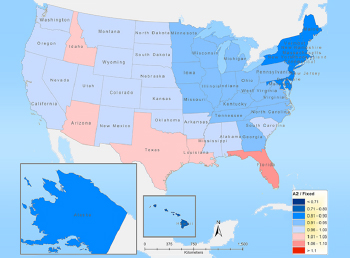Atmospher Sci & Global Chg
Research Highlights
December 2013
Analyzing How Climate Effects Buildings
Specially integrated model casts climate change impacts on buildings energy use in new light

Climate change impact on building energy use: ratio of energy use with climate feedback (A2) relative to that without climate feedback (fixed) in the 21st century. Enlarge Image.
Results: While assessing the impact of climate change on areas such as the Arctic ice caps may be what generates bold headlines, it is less conspicuous, but just as important, to discern how climate change can affect the way energy is portioned to maintain comfort and functionality in more immediate environments, such as buildings. In this effort, scientists from Pacific Northwest National Laboratory and the Joint Global Change Research Institute (a collaboration between PNNL and the University of Maryland) embedded a detailed, 50-U.S. state buildings energy module within the Global Change Assessment Model (GCAM), an integrated assessment framework. With it, they demonstrated the spatially heterogeneous nature of fuel consumption changes, such as electricity or natural gas, under climate change and showed that the 48 contiguous United States exhibit a large spatial heterogeneity. Their results also revealed widely distributed variations in increases of electricity use and decreases of natural gas and heating oil consumption in response to climate change. This spatial heterogeneity is heavily influenced by similar heterogeneity in climatic effects and dependent on heterogeneity in the scale of the buildings sector among states.
Why It Matters: While many studies have incorporated both bottom-up and top-down approaches for assessing climate change impacts on buildings energy use, notable limitations exist with both methods. By including the state-level detail to GCAM's buildings energy simulations, individual energy services categories (e.g., heating, cooling, lighting, and hot water) are fully coupled with socioeconomic development, technological change, and service price change—all of which are influenced by climate policy. This provides a more detailed and long-term representation of buildings energy uses and changing climate effects. This work also builds on existing efforts as part of PNNL's Platform for Regional Integrated Modeling and Analysis (PRIMA) Initiative to add spatial and temporal detail to GCAM and link it with detailed models of natural and human systems.
Methods: This study employed a detailed, service-based, 50-U.S. state buildings energy module nested in GCAM to understand the relationship between socioeconomic development and energy demand under climate change using estimates of heating and cooling degree days derived from downscaled temperature data. The scientists also evaluated sensitivity from assumptions about climate mitigation, population growth, gross domestic product growth, and choice of climate models, as well as compared the 50-state version of the buildings energy model with the national one by harmonizing key parameters. Comparisons of energy use from the national model and aggregated values from the 50-state model showed differences in sectors and an enlarged trend of difference over time, indicating the 50-state buildings energy model in GCAM may offer a more robust estimation of the total national-level effect of climate change on U.S. buildings energy demand along with unique region-specific details.
What's Next? When coupled with other more detailed models that can capture the temporal character of building energy demands, such as the Building Energy Demand, or BEND, model developed as part of the PRIMA initiative, the findings generated from this work will be especially helpful for infrastructure-planning exercises with the consideration of climate change. With this improved understanding, regulators and local utility infrastructure planners can develop more viable investment strategies and climate-based policy decisions to deliver reliable and efficient energy supplies for their service territories. In their work, the authors also identified the need for a robust set of spatially explicit estimates of driving forces, e.g., population and GDP, that could be used for more systematic sensitivity and uncertainty analyses.
Acknowledgments: The work described was supported by PRIMA, conducted under PNNL's Laboratory Directed Research and Development Program. The research also used Evergreen computing resources at PNNL's Joint Global Change Research Institute at the University of Maryland, which is supported by the U.S. Department of Energy, Office of Science's Integrated Assessment Research Program.
Reference: Zhou Y, L Clarke, J Eom, P Kyle, P Patel, SH Kim, J Dirks, E Jensen, Y Liu, J Rice, L Schmidt, and T Seiple. 2014. "Modeling the effect of climate change on U.S. state-level buildings energy demands in an integrated assessment framework." Applied Energy 113:1077-1088. DOI: 10.1016/j.apenergy.2013.08.034.
